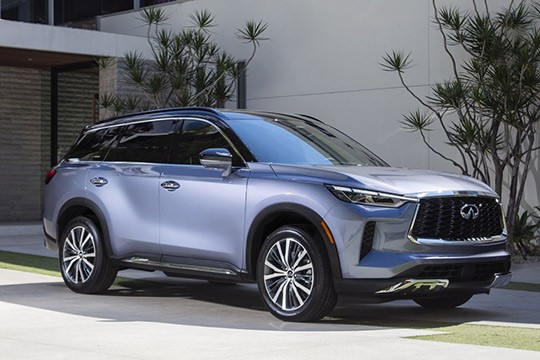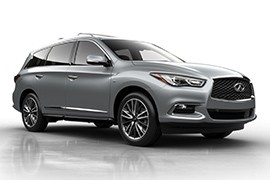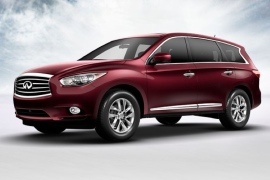INFINITI QX60 Models/Series Timeline, Specifications & Photos
First production year: 2013
Engines: Gasoline, Hybrid
Body style: SUV (Sports Utility Vehicle)
Infiniti broke its classic design language and entered into a new, uncharted map, with the 2022 QX60 revealed in June 2021.
Infiniti teased the second generation of the QX60 in February 2022, and its customers awaited to see the final product. However, the SUV still relied on the same Nissan D platform used for the Pathfinder, which means that it wasn't just showing and no go. Yet, the vehicle's look was far more critical for the Infiniti customers than the approach or departure angle.
At the front, the QX60 featured a new signature grille that suited the premium brand better than the previously used one. Its trapezoidal shape sported a rhomboidal mesh-grille with the brand's name engraved on the lower chromed slat. The LED headlights featured a three-part DRL mounted on their upper side, and their swept-back shape continued on the fenders. The carmaker installed tall and narrow scoops on the sides of the bumper, which created a more aggressive look for the seven-seat SUV. From its sides, the sculptured doors and rear quarter fenders were aerodynamically studied to lower the drag resistance, while at the back, the LED taillights mimicked the same shape as the headlights.
Inside, depending on the trim level, the carmaker added up to seven seats. For the top trim level, the Autograph, the QX60 featured captain seats in the middle row and a removable center console. All seats featured a zero-gravity design inspired by NASA, and the front seats were heated and ventilated. For the dashboard, the carmaker offered an option for a 12.3 touch-screen placed above the center stack. Like any other SUV from its class, the QX60 had to provide a good cargo area. With the third row folded, it offered 1,177 liters (41.6 cu-ft) of trunk space.
Under the hood, Infiniti placed its bets on a 3.5-liter V-6 engine paired with a nine-speed automatic transmission. In addition, the carmaker offered the QX60 with either front- or all-wheel-drive.
The battle for the big, seven-seat SUV segment was on, and Infiniti moved in 2013 with the QX60 range and upgraded it just three years later.
Infiniti needed a lighter seven-seat vehicle and chose the Murano platform to develop a new SUV on it. Its engineers increased the wheelbase and installed the third row of seats in the back. It was a bold move for the Japanese premium carmaker.
From the front, the QX60 showed its roots from the Infiniti brand with the specific design for the headlights. A broad mesh-grille completed their angry-looking shape with the chromed surrounding. The designers decided to add more chrome on the lower bumper area and on the sides. Its sculptured door panels featured a long, arched, ascending line toward the taillights.
Inside, the carmaker installed the same infotainment unit as the one from the rest of the Nissan range. Nissan believed that the 2-3-2 seating formula was a better choice than the 2-2-3 used by some of the American carmakers. Besides, it didn't offer enough shoulder room in the last row. It offered a 60/40 split-folding second row and a 50/50 third row of seats to increase the trunk size.
Under the hood, Infiniti chose the 3.5-liter VQ engine as its main powerplant, while a 2.5-liter hybrid was offered as an option.
Infiniti decided to change its vehicles' name and rechristened the JX35 as a QX60 for the 2014 model.
The QX60 was designed as a seven-seat vehicle to compete against the Audi Q7 or the BMW X5. Unlike the German rivals, it was available as a front- or all-wheel-drive vehicle, which allowed the Japanese carmaker to offer the SUV at a lower price than its competition and, moreover, to brag about its high fuel efficiency. The strategy worked, and the QX60 was a commercial success.
At the front, the car sported the same chrome-plated grille with horizontal slats. Its swept-back headlights featured corner-mounted turn signals in a narrow angular shape. The design team installed a curved, wrapped-around bumper at the front, with lines going on the sides on the front fenders. Depending on the trim option, the QX60 was available with chromed 20" light-alloy wheels.
Since it was based on the same platform as the Nissan Pathfinder, the QX60 featured a long wheelbase that allowed the carmaker to install standard three-seat rows. At the front, the carmaker installed a sloped-down dashboard with a rounded instrument cluster in front of the driver. On top of the center stack, Infiniti placed the infotainment system with its specific controls underneath. Its screen was not touch-sensitive. Unlike other carmakers, the seven seats were true to their words, offering adequate room even on the third row, while Infiniti spoiled the first and second-row occupants in comfort.
Under the hood, the QX60 was offered with a choice of gasoline or hybrid drivetrains, with either a front- or an all-wheel-drive system. The standard transmission for all versions was a CVT-type gearbox.


